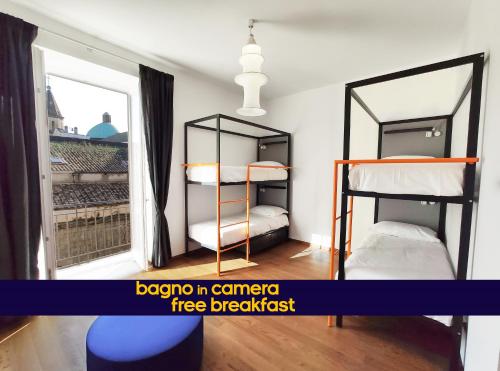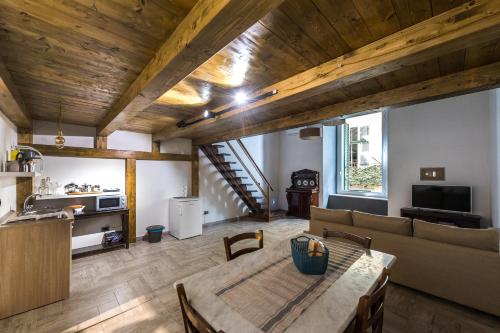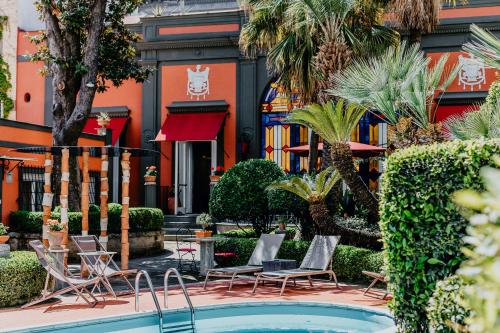In some ways, you need to put modern day Naples aside. The trash, the chaos, the petty crime, even the mafia – yes, it is a large part of what this Italian city is today. But it really doesn’t do Naples the justice it deserves.
I’ve written previously about this balance between good and bad and what Naples is really like. I would recommend having a read of it at some point.
The bad elements… well, they’re all a product of the Naples of today. And the good… well, most of them are from the history of Naples.
The history of Naples
It’s always been a wealthy and influential city. Even as empires rose and fell, Naples always seemed to have an important place for each wave of rulers.
Even as far back as 470 BC, when Greek settlers founded Neapolis (meaning ‘New City’ and then becoming ‘Naples’), it was one of the foremost cities in Magna Graecia and played a key role in the development of the Ancient Roman culture, based on Greek traditions.
In the more than two millennia between then and now, Naples was also important to the Roman Empire, the Byzantine Empire, and then the Normans, Swabians, and the Sicilian reign.
Between the 13th and 15th centuries, Naples was the most important city for the Angevin dynasty, which expanded its suburbs and built grand churches.
The Aragonese then controlled the city for the next couple of centuries and placed an emphasis on imposing castles and opulent palaces.
Then, from 1734, the Bourbon Kings embarked on probably the most ambitious architectural projects in Naples. The city became one of the major capital cities of Europe, full of incredible buildings, squares and boulevards.
Most of them are still here today, mixed in with the legacies of all the previous empires. Together, they create the infrastructure of magnificence that is the Historic Centre of Naples.
One day in the Historic Centre
With centuries upon centuries of history in the centre of Naples, it’s impossible to see everything in a day… or probably even a week.
Just walking the streets, you’ll find yourself surrounded by incredible buildings that appear to have no special status, that aren’t tourist sites, that don’t even look like they’re regularly maintained.
Walk aimlessly and you’ll probably actually see enough to give you a good impression of how impressive the architecture and history of Naples is.
But, to really get to see the best of Naples and to understand it properly, I would recommend a tour of the Historic Centre of Naples. There is this excellent private tour, if you are in a group. Or I would recommend this short tour to get a quick overall impression.
There are some other good options here too:
However, I know you might prefer to see things on your own. So, I’ve put together a suggested itinerary for one day in Naples, focusing on the historic centre.
It certainly won’t take you to everything (that’s impossible) but it will lead you to a bunch of the highlights.
A map of the Naples Historic Centre
My suggested route is in the Naples itinerary map below and I’ve also marked many of the important sights along the way. In the rest of this story, below the map, I have some brief information about what you’ll see along the way.
If you’re using your smartphone, just click on the icon in the top right of the map to open it in your Google Maps app and all of the markers will load up. Then, as you walk around, you can trace your route and see whether you’re close to something significant.
Things to see in the Historic Centre of Naples
If you choose not to take a guided tour, you’ll still be able to learn a bit about the most important attractions in Naples with this info I’ve put together.
Piazza del Plebiscito
I would suggest starting the day at the Piazza del Plebiscito, the enormous grand and open square near the coast.
It was originally designed in the early 19th century as a tribute to the French Emperor Napoleon but by the time it was finished, the politics of Naples had changed and the original plans had been changed.
It is named after the plebiscite in 1860 that brought Naples into the Kingdom of Italy.
Basilica San Francesco da Paola
On the western side of the piazza is the basilica called San Francesco di Paola. This is the building that specifically was going to be dedicated to Napoleon but it was converted into a church instead and was finished in 1816.
It is named for Saint Francis of Paola, who had stayed in a monastery on this site in the 16th century. Often the church isn’t open but it’s worth checking if you can go inside because it has a beautifully-decorated interior.
Royal Palace
On the other side of the piazza is the Royal Palace, which was built in the 17th century. In the 18th century, it became the royal residence of the Bourbons. The main part of the building is made up of four wings, with a central open-air courtyard.
You don’t need a ticket to go in the main gates, through the courtyard, and to the garden on the other side. You can even look through the glass doors of the entrance room with the grand staircase. To see other parts of the palace interior, you need to pay admission.
The Royal Palace is open daily from Thursday to Tuesday from 9:00 – 20:00.
It is closed on Wednesday.
A standard ticket is €15 and a concession is €2.
Castel Nuovo
On the other side of the Royal Palace (although you can’t cut through) is the Castel Nuovo. This imposing medieval castle was built in 1279 and was not just a fortification but also a residential palace. It was used as a royal seat until 1815.
The architecture of the castle is impressive and it’s worth buying a ticket to go inside.
However, I feel like the castle has seen better days and the visit is a little underwhelming. Quite a lot of the space is used for offices and as the base for various local institutions.
Castel Nuovo is open Monday to Saturday from 9:00 – 18:00.
A standard ticket is €6. Visitors under 18 and over 60 are free.
Galleria Umberto I
As you head back into the main shopping district of downtown Naples, make sure you go through the Galleria Umberto I. This beautiful shopping arcade was finished in 1891 and was one of the key buildings in a decades-long plan to beautify Naples at the end of the 19th century.
It fell into disrepair for a while, but you can see the restoration work (some complete, some ongoing). The central dome with 16 metal ribs is very impressive, but take some time to look at the detail on the floor as well.
Castel Sant’Elmo
From here, I would suggest going to the top of the city to Castel Sant’Elmo. The easiest way to get there is with the public funicular that leaves from the Augusteo stop just across from the galleria.
Castel Sant’Elmo is another medieval castle, with the first major fortification structure from the first half of the 14th century. Unlike other castles in Naples, the focus of this one was military and it was still used by them until the 1970s.
You can buy a ticket to go inside and look around the castle. There is also an art gallery as part of it. But one of the best reasons for coming up here is just for the views you get across the city and the Bay of Naples.
Castel Sant’Elmo is open every day from 8:30 – 19:30.
A standard ticket is €5 and a concession is €2.50.
Santa Maria de Sette Dolori
Even if you got the funicular up to Castel Sant’Elmo, I would recommend walking back down. Coming down a different part of the hill, you’re heading towards the centre of historic Naples, but first you’ll come across a small church called Santa Maria de Sette Dolori.
It’s a significant church and this building was constructed in about 1640. Go inside and you’ll see some beautiful artworks. But the main reason it’s worth stopping at is for the view.
Santa Maria de Sette Dolori sits at the very western end of a ‘decumanus’, which in Roman times was a major east-west road. From the church, it appears as though this road cuts right through the middle of the Historic Centre of Naples
Church of Gesù Nuovo
Gesù Nuovo is probably my favourite church in Naples, and you’ll find it as you come into the official historic centre of the city. From the outside, it’s not clear what the building is, because the facade is actually from the 15th century palace. But in the 16th century, the palace was converted into this beautiful church.
Go inside and you’ll see an incredible display of baroque art covering every part of the interior. The frescoes are on the walls, the vaults, and even the columns. It may take a while to walk through and see it all.
Outside the church, take a moment to enjoy the charming Gesù Nuovo piazza with the Spire of the Immaculate Virgin. Construction of the spire began in the 17th century toward off the plague but it wasn’t finished until 1750.
Gesù Nuovo is open Monday to Saturday from 9:00 – 12:30 and 17:00 – 19:15.
On Sunday it is open from 8:30 – 13:30 and 16:30 – 19:30.
Gesù Nuovo is free to visit.
Santa Chiara
Across the piazza is Santa Chiara, a religious complex with a church, monastery, tombs, and museum. The church is the most striking part of the complex and it’s free to go inside.
Construction of the church was finished in 1328 (although it was badly damaged in the Second World War and what you see today is a reconstruction).
It was decided to reconstruct it in the original Gothic style, rather than the Baroque style that it had been adapted to in the 18th century.
Church of Santa Chiara is open Monday to Saturday from 9:30 – 17:00. On Sundays, it is open from 10:00 – 14:00.
Admission is free.
Piazza Dante
It’s worth cutting through from here to Piazza Dante. It’s a beautiful square and is named after the large statue in the middle of the Italian poet Dante Alighieri. The buildings around it are stunning.
But what I love so much is the small alley called Via Port’Alba that comes off the square and is filled with quaint bookstores and small bars and restaurants.
Piazza Vincenzo Bellini
Next, I suggest passing through the Piazza Vincenzo Bellini. It’s another charming square, with a much quieter atmosphere than the others, and is a nice place to stop for a drink if you need a rest.
The most interesting thing here, though, are the exposed ruins that you can see in the middle of the piazza. These are part of the ancient walls from the Greek colony and are more than 2000 years old – giving you a link from the very beginning to today.
San Domenico Maggiore
Back on the main street that cuts through the Historic Centre of Naples, it’s worth stopping at the church of San Domenico Maggiore. It may not look like too much from the outside but it’s actually one of the most important churches in Naples.
It was finished in 1324 and was the royal church of the Angevins. There are some frescoes from the 14th century and some other incredible artefacts from the period.
The Basilica San Domenico Maggiore is open daily from 10:00 – 18:00.
Ticket prices are:
A complete tour is €11 and a concession is €8.
The standard tour (does not include the Carafa Crypt of Roccella) standard ticket is €8 and €6 for a concession.
Entrance to the Sacristy is €6 and €5 for a concession.
Naples Cathedral
Although you will have seen a lot of churches by now, you can’t miss the main Naples Cathedral. This enormous church is from the 14th century and has an incredibly high altar that stands out, even amongst so much beautiful art.
For the most lavish decorations, make sure you see the Royal Chapel of the Treasure of St. Januarius. You can also go down into the crypt.
Naples Cathedral is open dailyMonday to Saturday from 9:30 – 17:00, and opens at 9:00 on Sundays and holidays.
Entrance to the Naples Cathedral is free.
National Archaeological Museum
And the final stop on my suggested walking tour is the National Archaeological Museum. The building itself is of some interest and was built as a cavalry barracks in 1585. But it’s what’s inside that really counts.
The museum has an incredible collection of artefacts from across Italy and the world. But the reason I would particularly recommend visiting is to see the items that have been collected from Pompeii. If you’re planning to visit Pompeii, then it will give you a richer understanding.
If you’re tired from all the walking or haven’t left yourself enough time, I suggest coming back and spending a few hours here.
The National Archaeological Museum is open Wednesday to Monday from 9:00 – 19:30.
The museum is closed on Tuesday.
A standard ticket is €20 and €2 for a concession.
Guided Tours of Naples
So, even though I think I have outlined quite a comprehensive way to spend one day in Naples, I know it can sometimes be much easier to have a guide – and you do learn a lot more that way.
If you are interested in a guided tour of Naples, then I would recommend using one of the following options:
Or, even if you want to see the historical sights yourself, you might appreciate a local street food tour or a private tour of the street art and culture.
I spent quite a while in Naples and I was constantly finding new things in the city, even on streets I had walked every day. There’s such a rich history and of depth of culture here, that any tour of Naples – independent or guided – will probably only leave you wanting more.
It’s also worth staying in a good location in the city centre so you can easily explore but also be able to have a rest when you need. I’ve got some accommodation tips here:
THE BEST ACCOMMODATION IN NAPLES
I’ve got lots of tips about where to stay in Naples in another article, or have a look at some of the highlights below.
BACKPACKER

The bunk beds are fairly standard, but Tric Trac Hostel has a fun modern feel and a great breakfast.
APARTMENT

A large apartment with a cool design, Casa Calu makes a great base if you’re staying a while
BOUTIQUE

Like an oasis in the middle of the city, Costantinopoli 104 is set within a gorgeous 19th-century villa with a pool.
LUXURY

It doesn’t get much more luxurious than the Britannique Hotel, with fabulous suites and panoramic views.
Also, if you have any suggestions for sights in the city that you would recommend people see, please feel free to add them in the comments below.
Such a great detail and article you write up! These tips really helpful to explore the historic centre in Naples(Italy). Your photography really awesome!! Thank you so much for sharing a great experiences.
Keep sharing!
I am visiting Naples next week, and your post will be very helpful! I hope to have a chance to see most of the city’s sights. Naples looks really wonderful! Thanks for sharing!
This has been very helpful I don’t usually write comments but this article has been done perfectly. Thank you for your time 🙂
I found this really helpful in planning our stay in Naples in January. Thank-you!
My husband & I have travelled for years, but we have not been to Naples, Pompeii, or the Amalfi coast. We truly appreciate your map, suggestions, and detailed ideas.
Thank you!
What a fantastic guide! I can’t wait to explore the stunning architecture and rich history of Naples. The recommendations for local eateries are especially helpful! Thank you for sharing these insights!
I absolutely loved this post! The Historic Centre of Naples is such a treasure trove of history and culture. I can’t wait to explore the local piazzas and indulge in authentic Neapolitan pizza. Your recommendations for hidden gems are super helpful. Thanks for sharing!